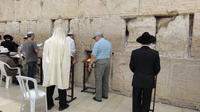Jerusalem Jewish Heritage Private Tour From Tel Aviv
Jerusalem, Israel
Trip Type: Historical & Heritage Tours
Duration: 8 hours
Jerusalem Jewish Heritage Tour is actually a must for any Jewish family, definitely for those who come to Israel for the first time. This tour will take you through 3000 years of Jewish Jerusalem creating a heart-beating experience of coming home.
More About This Activity All Historical & Heritage Tours →
Jerusalem Jewish Heritage Tour is actually a must for any Jewish family, definitely for those who come to Israel for the first time. This tour will take you through 3000 years of Jewish Jerusalem creating a heart-beating experience of coming home.We’ll start our tour at the Western Wall – “Kotel” as it is called in Hebrew. Visitors who stand at the Western Wall most often have a sense of not only the rushing presence of the “now-and here”, but also of all those who for centuries streamed to this, the most sacred place to the Jewish people. Two thousand years ago, it was a part of the most magnificent building Jerusalem had ever seen – The Temple.
We’ll further proceed to the Jewish Quarter, where plenty of religious and historical sites of worldwide importance are actually “squeezed” together. We’ll walk through The Cardo which had been Jerusalem's main street 1500 years ago, and is now one of the most interesting sites in the Jewish Quarter. And we’ll visit “Hurva” (“Destructed”) Synagogue, which was the largest building in the Jewish Quarter prior to its destruction during Israel's War of Independence. For decades only a lone arch remained as symbol of the Quarter’s destruction.
We’ll descend the Herodian Quarter, probably the most visually interesting site of the Jewish Quarter. Here, hiding in the basement of a modern Yeshiva, the remains of mansions dated from the late Second Temple period provide a peek into the life of the wealthy Jerusalemites in the days of Herod. Most of what we’ll see is well preserved for the last 2000 years - tableware made of glass to keep it kosher, and even furniture, ready to decorate any modern house. Special attention was given by the inhabitants to their bathing rooms, those we can find at every house - the flooring was composed of colorful mosaics, and the walls adorned by frescoes, to make bathing even more enjoyable!
From here we’ll proceed to the Holocaust Museum – “Yad Vashem”. Yad Vashem means actually “a Memorial and a Name” - "And to them will I give in my house and within my walls (a "Yad Vashem")... that shall not be cut off" - (Isaiah, chapter 56, verse 5). As the Jewish people’s living memorial to the Holocaust, Yad Vashem safeguards the memory of the past and imparts its meaning for future generations. Established in 1953, as the world center for documentation, research, education and commemoration of the Holocaust, Yad Vashem is today a dynamic and vital place of intergenerational and international encounter. Following the Museum’ path, we’ll be moving slowly down, from one room to another, through the inferno of the evolving Nazi atrocities. And then we’ll continue climbing up and up, through the stages of fight for life and freedom of the Jewish people, until we’ll finally see the Modern Jerusalem view from the huge terrace. A symbol of life and eternity!
We’ll further proceed to the Jewish Quarter, where plenty of religious and historical sites of worldwide importance are actually “squeezed” together. We’ll walk through The Cardo which had been Jerusalem's main street 1500 years ago, and is now one of the most interesting sites in the Jewish Quarter. And we’ll visit “Hurva” (“Destructed”) Synagogue, which was the largest building in the Jewish Quarter prior to its destruction during Israel's War of Independence. For decades only a lone arch remained as symbol of the Quarter’s destruction.
We’ll descend the Herodian Quarter, probably the most visually interesting site of the Jewish Quarter. Here, hiding in the basement of a modern Yeshiva, the remains of mansions dated from the late Second Temple period provide a peek into the life of the wealthy Jerusalemites in the days of Herod. Most of what we’ll see is well preserved for the last 2000 years - tableware made of glass to keep it kosher, and even furniture, ready to decorate any modern house. Special attention was given by the inhabitants to their bathing rooms, those we can find at every house - the flooring was composed of colorful mosaics, and the walls adorned by frescoes, to make bathing even more enjoyable!
From here we’ll proceed to the Holocaust Museum – “Yad Vashem”. Yad Vashem means actually “a Memorial and a Name” - "And to them will I give in my house and within my walls (a "Yad Vashem")... that shall not be cut off" - (Isaiah, chapter 56, verse 5). As the Jewish people’s living memorial to the Holocaust, Yad Vashem safeguards the memory of the past and imparts its meaning for future generations. Established in 1953, as the world center for documentation, research, education and commemoration of the Holocaust, Yad Vashem is today a dynamic and vital place of intergenerational and international encounter. Following the Museum’ path, we’ll be moving slowly down, from one room to another, through the inferno of the evolving Nazi atrocities. And then we’ll continue climbing up and up, through the stages of fight for life and freedom of the Jewish people, until we’ll finally see the Modern Jerusalem view from the huge terrace. A symbol of life and eternity!
« Go Back

